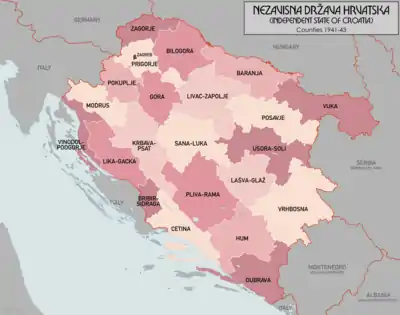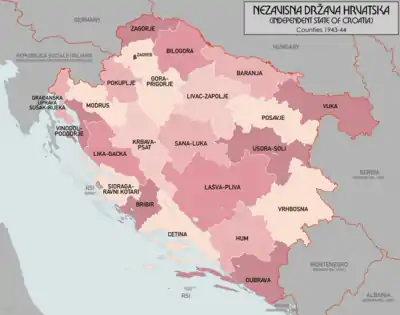The great counties or grand governorates (Croatian: velika župa, pl. velike župe, German: Großgespanschaft[1][2]) were the primary territorial subdivisions of the Independent State of Croatia. In 1941–1943, there were twenty-two of them, with the capital city of Zagreb serving as the twenty-third.

1941–1943

1943–1944
| County | Capital |
|---|---|
| Baranja | Osijek |
| Bilogora | Bjelovar |
| Bribir and Sidraga | Knin |
| Cetina | Omiš |
| Dubrava | Dubrovnik |
| Gora | Petrinja |
| Hum | Mostar |
| Krbava - Psat | Bihać |
| Lašva and Glaž | Travnik |
| Lika and Gacka | Gospić |
| Livac and Zapolje | Nova Gradiška |
| Modruš | Ogulin |
| Pliva and Rama | Jajce |
| Pokupje | Karlovac |
| Posavje | Slavonski Brod |
| Prigorje | Zagreb |
| Sana and Luka | Banja Luka |
| Usora and Soli | Tuzla |
| Vinodol and Podgorje | Senj |
| Vrhbosna | Sarajevo |
| Vuka | Vukovar |
| Zagorje | Varaždin |
| City of Zagreb | Zagreb |
See also
References
- ↑ Sattler 1943, p. 80
- ↑ Sundhaussen 1983, pp. 100–104
Sources
- Sundhaussen, Holm (1983). Wirtschaftsgeschichte Kroatiens im nationalsozialistischen Grossraum (in German). Dt. Verlag -Anst. ISBN 978-3-421-06150-8.
- Sattler, Wilhelm (1943). Die deutsche Volksgruppe im unabhängigen Staat Kroatien. Steierische Verlag Anst.
This article is issued from Wikipedia. The text is licensed under Creative Commons - Attribution - Sharealike. Additional terms may apply for the media files.